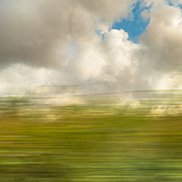At the April 14 opening (left to right): Collider CEO James McMahon, artist Marjorie Brown Pierson, Collider office and events manager Leah Donatelli, and artist representative Jessica Coffield.
Skipping Sun, 2006, Marjorie Pierson, from the Louisiana Marsh series, on view through August 28 at The Collider.
The Collider, a downtown innovation center focused on climate solutions, is now host to “Struck By Nature,” a traveling art exhibition from environmental artist Marjorie Pierson. “Struck by Nature” features visual art made in American landscapes directly impacted by climate change.
The public can view the exhibition and meet the artist at a free reception on April 7, 5:00 – 6:30 p.m., where Pierson will present a talk on the use of visual art to engage audiences on climate change issues. Attendees can also purchase copies of Pierson’s book at the event, Struck by Nature: Photographs from Bald Head Island, featuring unique barrier island landscapes in North Carolina.
The event coincides with the first art walk of 2017 in downtown Asheville. The Collider is located at 1 Haywood St., on the top floor of the Wells Fargo building, across from Pritchard Park.
A current resident of Durham, North Carolina, Pierson’s primary subject is evolving coastal wetlands, particularly those in her native south Louisiana. There, sea level rise and land subsidence are combining to sink a football field of wetlands into the Gulf every hour. An area the size of the state of Delaware has already been lost in Louisiana, and coastal communities are already flooding.
Pierson’s fine art photographs in this exhibition capture the powerful impact of hurricane storm surges in freshwater bayous and lakes, and the devastating impact of rising salinity in iconic cypress swamps.
“Art and science can work together beautifully,” Pierson says. “Visual art can inspire audiences to engage on environmental issues like climate change that might seem impossible to address.”
She has taught a course on this subject at Duke’s Nicholas School of the Environment, and her work is featured in museum, university, corporate and private collections.
“We are delighted to bring Marjorie Pierson’s work to Asheville – what is quickly becoming known as ‘Climate City,’” says James McMahon, CEO of The Collider. “As an innovation center providing opportunities for ‘strategic collisions’ between business and science to catalyze solutions for climate change, it is also important for The Collider as a nonprofit organization to offer educational programs where the public can learn about the impacts of climate change.”
The exhibition, organized by Jessica Coffield and on display through August, can also be viewed at The Collider by appointment. Contact Meredith Miles at 828-254-6283 ext. 101, Monday – Friday, 9 a.m. – 2:30 p.m., or email info@thecollider.org.
Those who attend other Collider events, such as the organization’s monthly climate and environmental film series, can also view the art. Visit thecollider.org and click on the EVENTS tab to view a calendar.
For more information about Marjorie Pierson’s work, visit marjoriepierson.com or contact the artist at marjoriepierson@gmail.com.
Young environmentalist Isabelle Pierson at The Collider with (at left) Duckweed #1, 2008 (38" x 38" framed) and Duckweed #4, 2009 (38" x 38" framed),
Cypress Flight, 2015, 48" x 32" from the Rare Earth series, at The Collider




